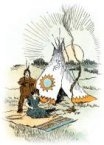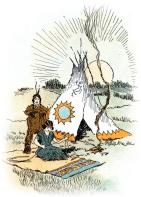
Worksheets and No Prep Teaching Resources
Reading Comprehension Worksheets
Native Americans

Native Americans
 Worksheets and No Prep Teaching Resources Reading Comprehension Worksheets Native Americans |
 Native Americans |
| edHelper's suggested reading level: | grades 4 to 6 | |
| Flesch-Kincaid grade level: | 6.16 |
|
Native Americans: The Plains Area
By Jennifer Kenny |

|
 1 The Plains area (or region) of North America stretches from the Canadian border to Texas. Its grasslands are located between the Mississippi River and the foothills of the Rocky Mountains. This region is 2,000 miles long and 500 miles wide. It covers over a half-million square miles. In 1800, there were 150,000 people and 60 million buffalo in the Plains.
1 The Plains area (or region) of North America stretches from the Canadian border to Texas. Its grasslands are located between the Mississippi River and the foothills of the Rocky Mountains. This region is 2,000 miles long and 500 miles wide. It covers over a half-million square miles. In 1800, there were 150,000 people and 60 million buffalo in the Plains. |
Create Weekly Reading Books
Prepare for an entire week at once! |
| Leave your feedback on Native Americans: The Plains Area (Grades 4 to 6) (use this link if you found an error in the story) |
 |
Native Americans
|
 |
United States
|
|
|
 | Fifty States Theme Unit |
 |
Document Based Activities |